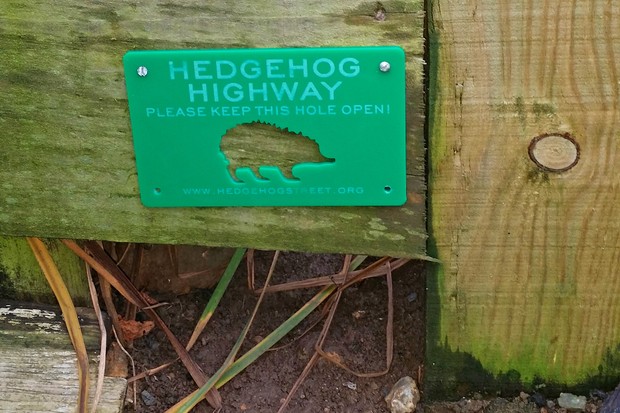
Hedgehog numbers are in decline. In rural areas, intensive agriculture has led to the fragmentation of habitats such as copses and hedges, resulting in fewer places to nest, hibernate and forage for food. Roads and motorways carve up habitats and create hazards. The use of pesticides, fungicides and herbicides may be behind the decline in their food, such as caterpillars, beetles and worms.
Find out what hedgehogs ned to thrive and how to help them, in our video guide to helping hedgehogs:
In urban and suburban areas, fences and walls prevent hedgehogs from travelling between gardens – they roam up to a mile each night in search of food. Ponds, netting, strimmers and slug pellets also create hazards. Paving over front gardens reduces food and shelter and forces hedgehogs onto roads to get to the next patch of green space.
More ways to help wildlife:
The good news, however, is that there is plenty that gardeners can do to help. Here are 10 simple steps that will provide hedgehogs with food and shelter.
1
Create access holes
How to help hedgehogs – hedgehog hole in a fence
One of the best things you can do for hedgehogs is to allow them access to your garden. Simply cut a hole, 12cm x 12xm, in the bottom of your fence. If you have a large garden, consider making holes at several points. If you get together with your neighbours, you can create ‘hedgehog highways’, allowing hedgehogs to roam greater distances.
Watch our Quick Tips video with Kate Bradbury, on how to attract hedgehogs to your garden:
2
Plant a hedge

A hedge is the perfect garden habitat, allowing easy access between gardens, and room for piles of leaves to accumulate beneath, where hedgehogs can forage, hibernate and raise their young. Native plants, such as hawthorn and hazel, will attract egg-laying moths, increasing your stock of caterpillars – a favoured food of hedgehogs. Follow our guide to planting a hedge.
3
Make ponds safe

A deep pond with steep sides is a hedgehog death trap. Hedgehogs can swim but quickly become exhausted, and find it impossible to climb out. Ensure your pond has sloping sides so hedgehogs can exit easily. Alternatively, drape thick rope netting over one side, or place a log at one end to act as a ladder.
4
Check before strimming

Hedgehog hospitals and rescue centres are full of hedgehogs with injuries caused by strimmers. To prevent injury or killing a sleeping hedgehog, check your long grass before using your strimmer. If you find any hedgehogs, move them from danger to a safe, secluded spot.
5
Avoid using slug pellets

Conventional slug pellets contain metaldehyde, which is lethal to hedgehogs. Wildlife-friendly, organic pellets contain the less toxic ferric phosphate, but they still take slugs and snails out of the food chain. Hedgehogs are slug predators, so taking steps to boosting hedgehog numbers will help control the slug population in your garden.
6
Make a hedgehog house

Hedgehogs need a dry, safe place to raise young and hibernate, and a hedgehog house is the perfect habitat. Ideally, cover it with plastic sheeting and a layer of leaves and make an entrance tunnel (around 12cm x 12cm and 40cm long) to prevent predators getting in. Site it under a north-facing hedge, out of the way.
7
Leave out extra food

While provision of natural food is the best option for hedgehogs, give them a helping hand with supplementary food, especially before and after hibernation. Offer meat-based dog or cat food, preferably chicken or turkey flavour. Avoid leaving out bread or milk as this can dehydrate and kill hedgehogs.
Watch our No Fuss video guide with Kate Bradbury, on how to make a hedgehog feeding station (many thanks to Sue Kidger, a hedgehog rehabilitator, for her kind help in making this video):
8
Grow native plants

Native plants such as honeysuckle, dog rose, hawthorn and blackthorn are caterpillar food plants for a wide range of moths, which lay eggs on the leaves. Most moth caterpillars descend to the ground to pupate before becoming an adult, where they become nourishing food for passing hedgehogs.
9
Retain twigs and leaves

A pile of leaves, logs or twigs left in a quiet corner of the garden – or a compost heap – makes the perfect hedgehog habitat, providing a warm, dry and secluded place for them to nest in and hibernate. Plus, small invertebrates, such as slugs, centipedes and beetles, will also take shelter here, providing food for hungry hedgehogs.
Found a hedgehog while tidying? Monty explains how to look after it:
10
Check bonfires

If you build a bonfire that includes twigs, branches and other garden waste, it could be mistaken for a hibernaculum. Either dismantle it and rebuild it just before lighting, or light it on the same day you build it. This will ensure that no hedgehogs or other wildlife have had a chance to creep into it.
Find out more
Visit Hedgehog Street to find out more about helping hedgehogs and how to become a hedgehog champion.
For more ways to help hedgehogs, check out our picks of products to help hedgehogs below.
